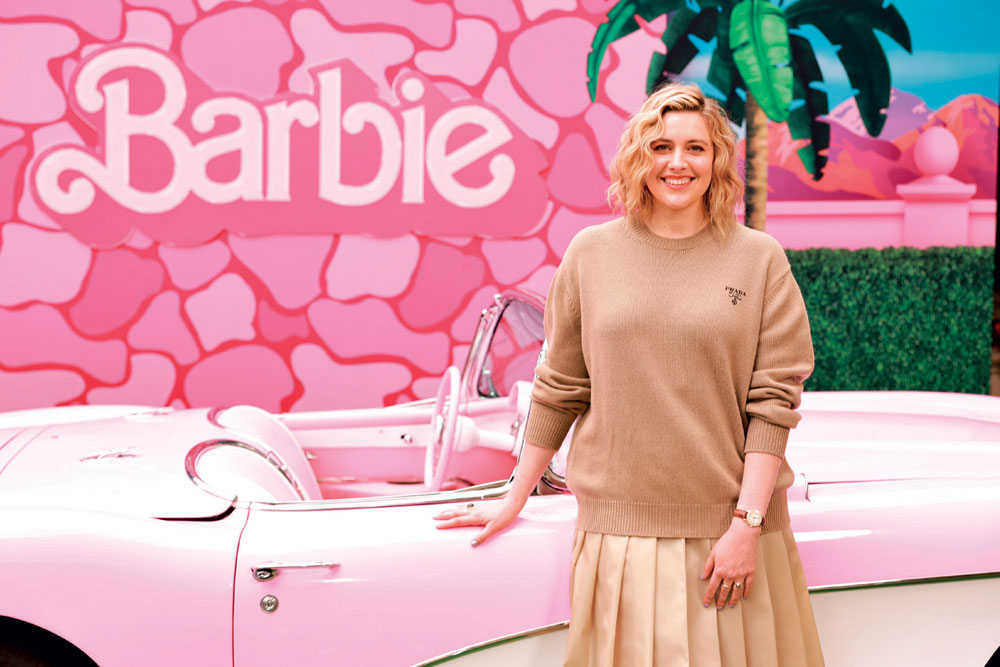The Pink Pantheon
The anarchic feminism of Barbie
 Nandini Nair
Nandini Nair
 Nandini Nair
Nandini Nair
 |
22 Dec, 2023
|
22 Dec, 2023
/wp-content/uploads/2023/12/Pinkpanth.jpg)
Ryan Gosling and Margot Robbie in Barbie
SIX MONTHS AGO, I WATCHED BARBIE IN A cinema hall, when it released. The movie, and the experience of watching it, lingers like the smell of baking, long after the cake has been consumed. On that Sunday afternoon the hall was packed with teens and twenty-year-olds dressed in their crop tops and high heels, crowned by mascara and well-defined eyebrows, complete with capsule bags with golden straps. And yes, the majority (including I) was clad in pink. The following two hours was a feminist lecture delivered in candyfloss tones. The best part is you came out feeling enthused (‘empowered’ would be a stretch) and piqued. Like you’d been fed on chilli hot chocolate. It had the slightest bite of spice and the wholesomeness of cocoa. It is both escape and a call to arms. This is feminism for the masses, packaged in candy colours, complete with song and dance, and I am all for it. And so were the hundreds of ladies in the hall who cheered and hooted when the Barbies got their constitution back, and who sang along to ‘Barbie World’ as the credits rolled.
Since its release Barbie has been met with acclaim. The headline of the Rolling Stone review read; “Barbie May Be the Most Subversive Blockbuster of the 21st Century”. The official website of the legendary critic Roger Ebert said, “Barbie, director and co-writer, Greta Gerwig’s summer splash, is a dazzling achievement, both technically and in tone. And the high priest of cinema Richard Brody of the New Yorker called it “brilliant, beautiful, and fun as hell”.
Barbie is all of the above. It is feminist. It is subversive. And it does all of it with dollops of humour. There is a lot of wink-wink, nudge-nudge and even jokes about Proust that probably two people in the New York audience got. (I was not one of them.) It sizzles with references and inside jokes about popular culture, which often reveal themselves only on a repeat watch. It is a roller-coaster ride through Feminism 101, where you will find yourself upside down and examining power structures, seeking to dismantle them, and embracing pluralism and diversity. But it ticks these boxes with both self-awareness and mirth. To its credit it can include a line like—“By giving voice to the cognitive dissonance required to be a woman under patriarchy you’ve robbed it of its power”— in a summer blockbuster. Barbie reveals that feminism is fun. And patriarchy is ridiculous. Unlike so much of filmmaking today (especially when it comes from the crop of famous male directors), Barbie never takes itself too seriously. It is not proclaiming to the world that this is my ‘serious art’ on a ‘serious theme’ that must be taken seriously by the world. (A movie which released that same week on a very serious topic does precisely that). Instead Barbie reminds us that Real World often sucks and our escape route is imagination. And if along the way, we can create a more equitable world, then well done to all of us.
The first few minutes lays out Barbie’s intentions by reimagining the opening sequence of 2001: A Space Odyssey. From the Dawn of Man we move to the Dawn of Barbie. Here instead of apes using a bone as a weapon for the first time, young girls dressed in brown pinafores, in a prehistoric landscape, play with dolls. The problem with playing with baby dolls (the narrator Helen Mirren tells us) is that the girls could only imagine themselves as mothers. Which can get rather boring, we just need to ask our mothers. The sequence from Space Odyssey is a pantomime of aggression and carnage. The apes bludgeon an ape, and pummel him long after he has stopped moving. The scene heaves with violence. In Barbie the opening reveals a familiar scene in an unusual setting. Girls pushing dolls in a pram, girls brushing a doll’s hair, girls feeding a doll, but all in a barren desert-like landscape. With ‘Thus Spoke Zarathustra’ rising to a crescendo in the background the girls see a larger-than-life Barbie for the first time. She (Margot Robbie) of the endless legs and bee-bitten red lips. In that instant the girls realise that they are so done with baby dolls. And as the apes used the bone as weapon, they now thrash their toy teacups with their once-loved dolls, destroying both. The appearance of Barbie shows the girls that they can be so much more than just mothers. They can be anything they want. And with that, in the first two minutes of the film, we get the first (and most basic) feminist lesson of Barbie. Be a mother if you wish. But there are also umpteen other roles that can coexist with motherhood, from an astronaut to a doctor to a lawyer. Essentially, Barbie can be anything she wants. She can own her own house, have her own money, and most importantly, be independent.
Barbie reveals that feminism is fun. And patriarchy is ridiculous. This is feminism for the masses, packaged in candy colours, complete with song and dance. Watching it feels like you have fed on chilli hot chocolate. It has the slightest bite of spice and the wholesomeness of cocoa. It is both escape and a call to arms
This opening sequence is also a pithy reminder of the Barbie Origin Story. Ruth Handler, the co-founder of toy manufacturer Mattel, noticed that her daughter Barbara (after whom Barbie is named) role-played adult scenarios with baby dolls. So, she decided to create adult dolls. In Barbie we learn of this connection only towards the end, when the inventor of Barbie (who haunts an office in the Mattel building) shows up to give Barbie some life advice, and closure.
Barbie has rightly been called a “fantasy about a fantasy”. Here there are two worlds, one is Barbie land, where women (or Barbies) rule. Here the Mount Rushmore has only women’s faces. Here every night is girls’ night. Here “Barbie has a great day every day. But Ken (the excellent Ryan Gosling) has a great day only when Barbie looks at him.” This world and the film’s tagline: “She’s everything, he’s just Ken,” has infuriated the likes of TV presenter Piers Morgan, because they see it as an “assault on men”. What can one say to that? Those male egos are like candyfloss if they can be punctured just by a doll that is truly living her best life. Barbie land is perfect for Barbies. Not so much for Ken who doesn’t know who he is and can only see himself in relation to Barbie.
The Barbies believe, “Thanks to Barbie, all problems of feminism and equal rights have been solved.” When Stereotypical Barbie (Robbie) starts having thoughts of death and when her always-in-stilettos feet collapse to the ground, the Barbies realise she is “malfunctioning”. The only way to fix this is for her to go to the Real World to find herself and her purpose.
When Barbie and Ken enter Real World, much to Ken’s joy and Barbie’s horror, they realise it is nothing like Barbie Land. It is quite the opposite in fact. Here women are leered at and pushed aside while men (and horses) rule. Unlike Barbie land, it is devoid of wholesomeness and camaraderie. Barbie finds that men pass rude comments at her and try to cop a feel. She (rightly) punches the perpetrator in the face. Through the eyes of Barbie and Ken we see how differently the world is experienced by women and men. Ken is gobsmacked to find the faces of men everywhere, from currency notes to billboards. He soon realises; “everything exists to extend and elevate the presence of men.” We, the viewers, do realise how imbalanced the world (and its gender equation) would appear to aliens if they were ever to land on Earth from outer space.
DIRECTOR GRETA GERWIG KNOWS that a film like Barbie will be seen as a commercial enterprise that celebrates Mattel. But what she knows even better is that it is hard to make fun of those who make fun of themselves. She preempts the criticism by including Mattel into the fabric of her film. Right from the start we know it is a Mattel production. In the Real World the ubiquitous M of McDonald’s becomes the M of Mattel. Barbie is destroyed in her first encounter with a human. Sasha (the daughter of Gloria, a Mattel employee who helps Barbie in the real world) tells Barbie that she has been making women feel bad about themselves since she was invented, and she represents “everything that is wrong with our culture; sexualised capitalism unrealised physical ideals”. By incorporating this criticism, Gerwig is one step ahead of her critics. She knows Barbies are double-edged. They can tell girls that they can be anyone they want, but Barbies can also be injurious for girls with their ‘life is plastic, it’s fantastic’ aesthetic.

Mattel has brought us Barbie and Gerwig acknowledges and mocks this. In a terrific scene, Aaron Dinkins, a junior employee at Mattel goes all the way to the C-Suite to deliver the breaking news that fantasy Barbie has entered Real World. He walks into a fancy-shmancy boardroom where a dozen suited and booted men sit around a table presided over by the CEO of Mattel (Will Ferrell). Here (without a single woman present) they talk about the “empowerment of girls”. In a moment that had me laughing out loud, the CEO asks, “When you think of sparkle, what do you think of after that?” He answers without waiting for a reply, “Female agency”. Agency is a term overused by feminists and academics, and tut-tutted at by old-schoolers. By throwing it with ‘sparkle’, Gerwig shows how an important term (and concept) has been diminished. There is nothing in common between ‘female agency’ and ‘sparkle’, but men and businesses will try to add more dazzle to ‘agency’ to make the medicine go down easier.
In the mattel boardroom Greta Gerwig has the most fun. Here we get zinger after zinger. This all-male boardroom is all about chest thumping and back patting, where the seniors grace chairs and the junior squats on the ground. When Barbie asks to meet the woman in charge, the CEO, she is told that all the senior positions are occupied by men
In the Mattel boardroom Gerwig has the most fun. Here we get zinger after zinger. This all-male boardroom is all about chest thumping and back patting, where the seniors grace chairs and the junior squats on the ground. When Barbie asks to meet the woman in charge, the CEO, she is told that all the senior positions are occupied by men. Here the lowly Aaron Dinkins adds, “I am a man with no power, does that make me a woman?” His deadpan delivery only adds to its whiplash effect. The Mattel CEO realises that the situation might be getting out of hand, and says, “We are a company literally made of women. We had a woman CEO in the ’90s.” The whole scene would be a farce if itdid not ring true of reality. The CEO makes a bad situation worse by adding, “We have gender-neutral bathrooms up the wazoo.” Which reveals both the codger’s contempt, and the futility of such ‘inclusive’ gestures, when they are not properly executed.
Barbie’s feminist mojo is at its best in these well-tailored scenes rather than when we get an entire lecture on feminism by Gloria in the middle of the movie. The dialogues are all quote worthy, but after a point they can feel too heavy-handed and preachy. But sample some of it; “We have to be extraordinary, but somehow we are always doing it wrong…You have to be thin, and not too thin, and you can never say you want to be thin, you have to say you want to be healthy but also you have to be thin…You have to have money, but you cannot ask for money because that is crass…You have to be a boss, but you can’t be mean…You are supposed to love being a mother, but don’t talk about your kids all the damn time.” Delivered as rap, or as a ballad like ‘I am just Ken’ by Ryan Gosling, the speech would probably have been more effective and less priest at a podium.
Coming to Ken. He is quite simply the best foil to Barbie in a feminist movie. He embodies all the alpha-male qualities, where his jaw is as chiselled as his abs. At first, all he wants is Barbie. But on his return from Real World he realises he can have his own “Mojo Dojo Casa House” and his very own Kendom. His transition from Doofus Ken who just wants Barbie’s attention to Jaat Ken driving a Hummer and back to Romeo Ken just looking for love is simply marvellous. He must go through these various avatars to realise that he is not just Ken of ‘Barbie and Ken’, instead he can be just Ken. Or as his sweatshirt reads in the penultimate scene, he is KENough!
Ken is a feminist character because he is open to change. He needs to see himself beyond his house or his mink coat or his relationship to understand who he is. And the future for Barbie is not as a CEO or a musician (she has done all that) but as Ordinary Barbie. “She is not extraordinary, she is not president of anything, maybe she is, maybe she is a mom, maybe she is not…she just has a flattering top and she just wants to get through the day feeling kinda good about herself.” Finally, that is what Barbie is telling us. Being Barbie is not the goal, being ourselves is. And that is feminism at its best.

/wp-content/uploads/2025/05/Cover-AfterPahalgam.jpg)












More Columns
The Asia University Ranking 2025 Declared Open Avenues
REVA University Open Avenues
ICFAI: Nurturing Excellence through Innovation Open Avenues